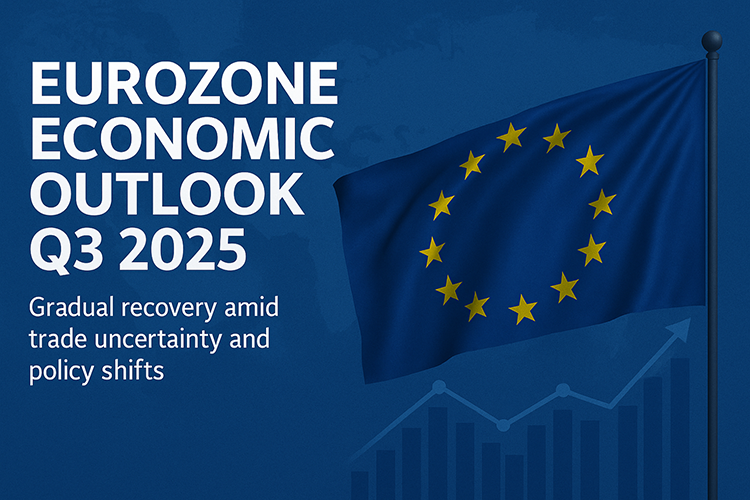Eurozone Economic Outlook Q3 2025: Gradual recovery amid trade uncertainty and policy shifts
The economic outlook for the eurozone in the third quarter of 2025 suggests resilience despite external pressures, particularly in trade. S&P Global Ratings expects the recovery in domestic demand to continue, driven by strong private sector balance sheets, supportive fiscal policies, and a robust labor market. While U.S. tariffs and global geopolitical tensions present downside risks, they have not significantly derailed internal economic momentum.
Eurozone growth remains modest at 0.8% for 2025, with projections of 1.1% in 2026 and 1.4% in 2027. While external trade volatility has affected short-term output, domestic demand, especially in household and business investment, has strengthened. Business investment growth surprised on the upside in early 2025, contributing significantly to GDP expansion. This early rebound has led to adjusted forecasts, with higher investment growth in 2025 and slightly lower projections for 2026.
Tariff-related concerns have been revised, with assumptions of higher U.S. import duties on European steel and aluminum now at 50%, potentially impacting Italy and Germany more acutely. Nevertheless, the overall impact is still within S&P's base-case scenario. Domestic inflation remains subdued due to a stronger euro and lower energy prices. Core inflation is expected to remain near the ECB's 2% target, reducing the likelihood of additional rate cuts unless significant external shocks occur.
Labor market dynamics remain a key strength of the eurozone. Employment has reached new highs, with a record low unemployment rate of 6.2%. Job creation has been especially robust in the ICT, professional services, health, and education sectors, though manufacturing continues to decline. Older workers and women make up a growing share of employment gains.
Public spending plans, particularly in infrastructure and defense, are expected to contribute to economic acceleration post-2025. Germany and the broader EU have outlined significant but still largely undefined investment packages. NATO's proposed increase in defense spending and EU initiatives like the ReArm program could further bolster medium-term demand and support industrial output.
The inflation outlook remains uncertain. While current indicators point to continued moderation—thanks to a stronger euro and lower oil prices—future inflationary pressures could emerge from fiscal stimulus, labor market tightness, or energy market disruptions. S&P estimates that if oil prices exceed assumptions by 10%, inflation could rise to 2.0% in 2026.
The ECB has signaled a pause in its rate-cutting cycle, maintaining the deposit rate at 2.0%. This reflects stable core inflation and improving domestic demand. Markets anticipate little likelihood of further cuts in the near term, with potential rate hikes possible in 2027 if inflation pressures intensify. Quantitative tightening continues, reducing excess liquidity and steepening the yield curve.
Trade negotiations between the EU and the U.S. remain a critical factor. S&P's baseline scenario includes moderate U.S. tariffs, but more aggressive measures could lower eurozone GDP growth by up to 1.1%. The impact varies by country, with Germany and Italy more exposed due to their export compositions. Proposed EU countertariffs could marginally increase inflation, though household savings are expected to cushion the blow to consumer demand.
Overall, the eurozone enters the second half of 2025 with steady internal growth, a strong labor market, and moderating inflation, though external uncertainties, particularly in trade policy and geopolitical developments, continue to pose risks to the outlook.
Source: S&P Global Ratings









